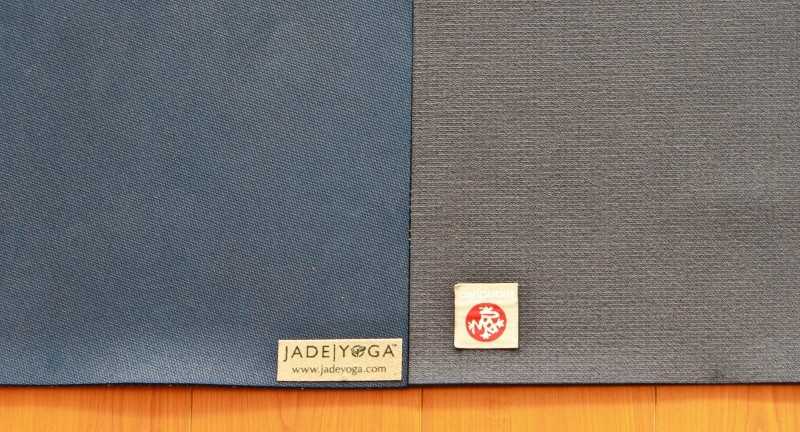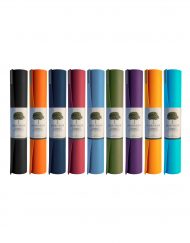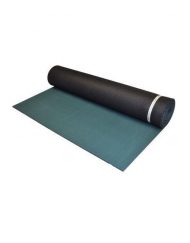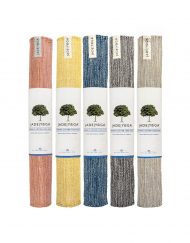Jade vs. Manduka: Yoga mat throwdown


Photo: Flickr/LululemonAthletica
New York is filled with fitness rivalries: Mets vs. Yankees, Flywheel vs. SoulCycle, and now Jade vs. Manduka—the manufacturers of the best-selling yoga mats.
Even though a non-competitive, live-and-let-live spirit pervades yoga philosophy, yogis take sides when it comes to mats. Considering that it’s the only major piece of equipment required and an important decision, maybe it’s no wonder?
Studios have their preferences, too, based on the loaner mats they stock: You’ll find devotees of Jade at Jivamukti and Manduka at Kula Yoga Project.
We spent months sweating on both Jade and Manduka mats—and tapped the Well+Good community on Facebook and Twitter to hear what makes someone a die-hard fan of one mat or the other. What’s the best mat in class? Read on:
New York yoga luminaries Sharon Gannon and David Life of Jivamukti pose for Jade yoga mats
JADE, www.jadeyoga.com
Jade is currently New York City’s “it mat.” It has an all-purpose reputation and a democratic price point ($64.95 for the premium Harmony model and $49.95 for travel or those who carry their mats everywhere). All Jade mats are made from tree rubber, and with every purchase, the company plants a tree, which kinda makes it hard to find fault.
Though some yogis are fickle, most readers we talked to loved the stability and stickiness of Jade mats—3:1 over Manduka—and Jade loaners seem to be found in more NYC studios (according to our admittedly non-comprehensive quest).
But some hard-core yogis complained that the stickiness doesn’t work for vinyasa or flow-based styles. “In chaturanga to up-dog transitions, you need to slide your feet back a bit as you roll over them for correct alignment. Yogis with a strong core and floating ability can manage to slip their feet back on a Jade. But for most of us, this is very difficult,” said one reader. Another complained that after a spell in hot yoga it “stretches all over the place,” but she loves it so much she’s just going to get another.
Other assets mentioned: It doesn’t come with that slick “just-manufactured film” that you have to wash off with apple cider vinegar. And it’s not “heavier than a medicine ball.”
Takeaway: Jade’s got mass appeal—hitting the right combination of affordability, stickiness, and tote-ability for most New Yorkers.
(Photo: Tiffany Assman, Flickr)
MANDUKA, www.manduka.com
The Rolls Royce of yoga mats. Manduka has yogis throwing down $90 for itslegendary Black Mat Pro, and $100 for limited edition colors—currently a black sapphire. The Black Mat Pro is favored by many yoga teachers, has a lifetime warranty, and its deep cushion and non-slip bottom make it a far cry from the plastic sheets many New York City yogis are used to practicing on.
The aspirational price tag yogis can overlook, but not the Black Mat Pro’s weight problem. Because it tops 7 pounds, it’s “super impractical” for yoga-mat-toting New Yorkers. Said one yogi: “For me [the choice is about] weight over almost anything else. The Manduka is super sturdy (whereas I usually have to replace my Jade mats every 9 months or so), but it’s SO. FREAKING. HEAVY.”
Manduka’s lighter mats, like the Manduka Pro Lite ($68–$70), cost less and still feel sturdy. But the yogis we talked to either loved it and how it folds up or found it “ice-rink slippery.” Perhaps more a factor of a yogi’s sweat production than the mat’s construction? The popular Manduka Eko mat (made with tree rubber and subject to kleptomania) has the “slight slip required for chaturanga transitions.” The Eko Lite ($36–$42) can “buckle a little on the floor” but is otherwise “a great option.”
Takeaway: The pricey Black Mat Pro is more of a commitment—and its 7-pounds-of-cushion make it best for yoga teachers and yogis who leave their mats at a studio. Manduka’s light-weight models are solid spin-offs. —Melisse Gelula
Got an opinion about your yoga mat? Tell us in the Comments area, below.
Article Source: http://www.wellandgoodnyc.com/2011/03/28/jade-vs-manduka-yoga-mat-throwdown/















